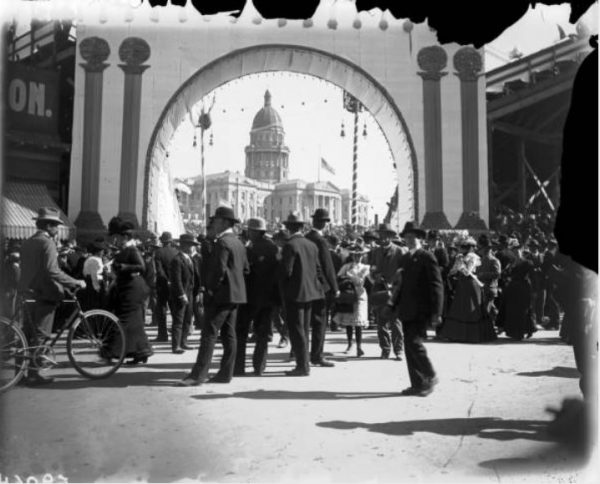In 1895, Coloradans were looking for something to lift their spirits. Two years before, the state had been devastated by the worst economic crisis in its history. But after a couple of years had passed, the state was slowly recovering. So, what better way to boost morale and celebrate Colorado’s resilience than with a giant party? The Festival of Mountain and Plain, as it was to be called, was planned by a committee of leading Denver citizens overseen by booster extraordinaire William N. Byers, the founder and former owner of the Rocky Mountain News.
Held October 16-18, 1895, the festival kicked off with an enormous parade through the streets of Denver. In celebrating the state’s economic recovery, the parade featured floats highlighting Colorado’s various industries — mining, agriculture, manufacturing — as well as floats from Denver school children and civic groups. A second, military parade was held the following day. In the evenings, 16th Street “from Larimer to Broadway” was lit with “over 3,000 electric globes.” The final day of the festival included a band contest, a miner’s drilling contest, “exhibits showing the resources of the state,” a free football game, and, in City Park, an “Indian Festival” with “dances, sports and ceremonies by Ute and Santa Clara Indians.” The festival culminated with a Grand Allegorical parade featuring the “Silver Serpent.” Because Colorado’s reliance on silver mining had been the cause of the 1893 crash, the festival symbolized the defeat of the “serpent.”
The festival was considered an enormous success, with over 100,000 people attending. The event was so popular that it was held again each October through 1899. Each year, new attractions were added: a “Balloon Ascension and Parachute Jump” in 1896; an enormous outdoor masquerade ball in 1897; a horse show in 1899. After this time, however, interest began to wane. Festival organizers skipped 1900 and tried again in 1901, but this festival was not nearly as successful as it had been in the 1890s. A final attempt was made in 1912, but again, the festival failed to make enough money and to attract the numbers that it had during its first years. Those years, however, became legendary and the festival was long remembered in the memories of those who had lived in Denver in the 1890s. Today’s many downtown festivals have their roots in the great Festival of Mountain and Plain.
In 1948, Levette J. Davidson published a two-part history of the Festival of Mountain and Plain in the Colorado Magazine. Part 1 can be found in the July issue and Part 2 appeared in the September issue. The articles present a detailed look at the festival programs, the reasons for its discontinuance, and some great photos of the floats and festivities.

- How to Spot the Differences Between Eagles and Hawks - August 16, 2021
- How Transportation Projects Help Tell the Story of Colorado’s Past - August 9, 2021
- Time Machine Tuesday: The Night the Castlewood Canyon Dam Gave Way - August 3, 2021